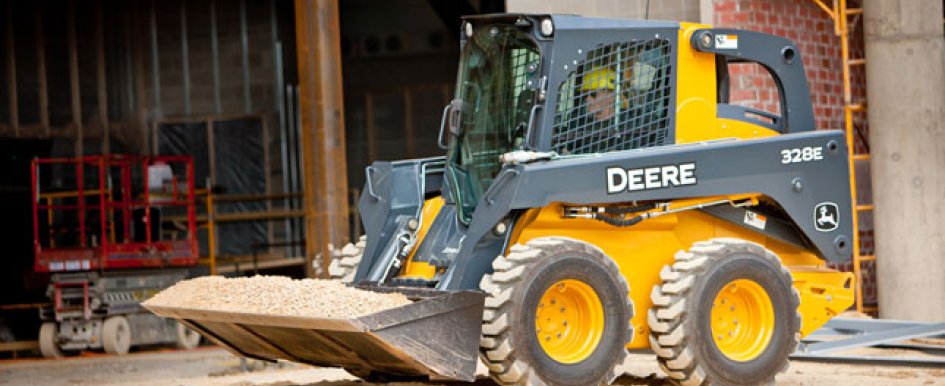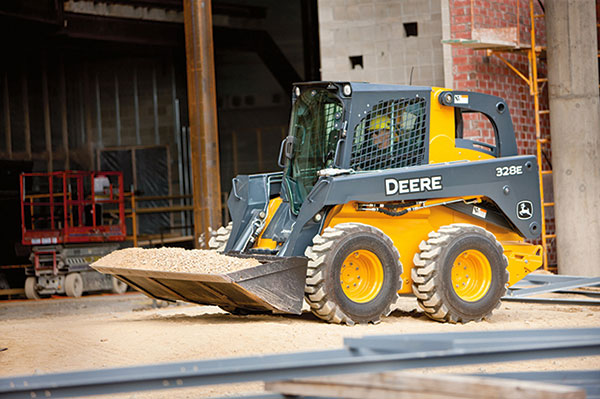
How do you design a piece of equipment that allows operators to be productive and comfortable? You ask them what they want and develop products using their feedback. There are six main characteristics operators assess when looking for a skid steer: visibility, comfort, simplicity, attachments, power and capacity.
Jobsite Visibility
When operating equipment of any type, operators need to know what’s going on around them. They want machines that provide structural visibility to see the jobsite and the surrounding area clearly. If they’re using attachments, they want to have a clear view to use them properly and safely.
They may not realize it, but operators are constantly contorting their bodies and increasing fatigue levels to get the job done, performing actions such as turning around in the seat to see behind them and getting in and out to change attachments. By reducing the physical strain on the body, a machine can increase worker productivity and safety. Simple things such as an adjustable seat, a rear-review mirror option, excellent rear visibility and a large door opening can offer great sightlines around the machine.
A Comfortable Cab

A comfortable operator is a productive operator. Comfort starts with the seat and controls. Having the right body position, posture and control setup will maximize comfort. Cabs should also be designed to accommodate operators of all sizes, allowing them equal ability to adjust the lap bar and use the controls comfortably.
Construction sites are often loud, so a well-designed skid steer should be able to separate noise and vibration from the operator station. Operators are also asking for pressurized cabs with climate control to keep them comfortable and to keep the dust out. This comfort will allow them to complete jobs more quickly.
Operator Controls
The first skid steers featured mechanical linkage controls and were not ergonomic, so significant effort was required to operate them. Electronic-hydraulic controls offer practically no resistance and are easy to use. Machine control is at the tip of the fingers. No longer do operators have to utilize their hands and feet to move the piece of equipment.
Operators have different control-style preferences from one another, and many machines are used by multiple operators. Switchable control systems allow operators to choose between ISO, H and foot-control patterns to match their preferences or skill level.
Operators can also program skid steer joysticks to do seemingly anything they need, including operating attachments, changing travel speed and adjusting boom and bucket speeds. The industry will continue to move toward more automatic features, like attachment positioning, to enhance productivity.
Other machine options gaining popularity include ride control, which provides comfort when moving loads at high speeds or over longer distances, and a reversing fan that provides automatic cleaning on the machine’s coolers when operating in high-debris applications.
Attachments
Perhaps the most common reason contractors purchase skid steers is that they are versatile. Today’s machines have the ability to connect with hundreds of attachments, from buckets and pallet forks to augers and breakers. Skid steer owners like to be able to connect and disconnect quickly. They also want to be able to connect and disconnect the attachments from the inside the cab. The more times they exit the cab to hook up an attachment, the less time they have to complete the job. With more and more operators using hydraulic attachments, a connect-under-pressure auxiliary coupler design will reduce the effort it takes to connect hydraulic lines to the machine.
Machine Power
If there is one thing every operator wants, it’s more power. While balance and stability is key, increased horsepower allows operators to get the job done faster. Bucket breakout force and boom breakout force also significantly affect productivity. Bucket breakout force is the machine’s ability to tilt back to get a heavy load off the ground. Boom breakout force is the ability to lift heavy loads to the top of the boom height, allowing material to be dumped into a truck or placed on a high location.
An increase in power should not come at the expense of stability. A stable machine allows contractors to work on steeper slopes and offers less risk of tipping or rolling. Operators want stable skid steers that can maneuver over small hills without bouncing them around the cab.
Capacity
Another key consideration is boom loader performance. Operators ask for strength, but lift height is also important. A 10-foot-high lift path is ideal, as it will clear the height of a dump truck.
Operators also want more reach. Since skid steers are used to complete a variety of tasks, the machine will need to reach far enough over a truck bed to drop off and pick up a pallet. The machine’s reach at truck bed height is also important. An adequate reach at four to six feet off the ground is necessary for loading in the middle of flatbed trucks.
As the skid steer market continues to grow, manufacturers will continue to offer features to simplify work, increase productivity and reduce operating costs.
